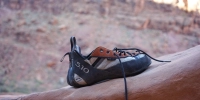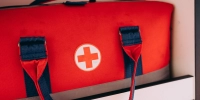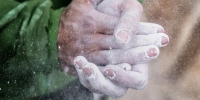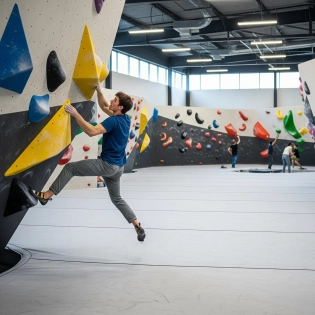







Climbers Point
Climbers often appear hunched due to the nature of the sport. When climbing, we engage our upper body muscles, particularly the back and shoulders, to maintain balance and stability on the wall. This can lead to a forward-leaning posture, which may give the impression of being hunched. Additionally, climbers frequently need to reach for holds above them, requiring a slight forward lean to generate upward momentum. So, it's a combination of using our muscles and body position that can make climbers seem hunched while on the wall.
Rock climbing can put strain on your feet, but whether it causes damage depends on various factors. The repetitive pressure and friction can lead to calluses, blisters, and even corns. However, these issues are typically temporary and can be managed with proper foot care and footwear. The use of climbing shoes, which provide a snug fit and a specialized rubber sole, can help improve grip and protect your feet. It's important to listen to your body and take breaks if you experience discomfort or pain.
It depends on your goals and preferences. If you prioritize climbing performance, it's generally better to climb when you're fresh and have the most energy. In that case, running after climbing can be a good way to incorporate cardio without compromising your climbing session. Running after climbing can also serve as a cool-down activity.
On the other hand, if your primary goal is running and you want to maintain or improve your running performance, it may be better to run before climbing. Running before climbing can help warm up your muscles and prepare your body for the climbing session. Just be mindful that running beforehand might affect your climbing performance if you're already fatigued.
Running can be beneficial for rock climbing in several ways. It helps improve cardiovascular endurance, which is essential for sustaining climbing efforts over longer durations. Running also aids in overall fitness, weight management, and strengthening leg muscles, which can be advantageous for certain climbing techniques and approaches. Additionally, running can enhance mental resilience and focus, which are valuable attributes for climbers.
Climber's elbow, also known as medial epicondylitis or golfer's elbow, can improve and eventually go away with proper treatment and rehabilitation. It typically involves inflammation or damage to the tendons on the inside of the elbow. The recovery time can vary depending on the severity of the condition, adherence to treatment protocols, and individual factors. Rest, ice, stretching, strengthening exercises, and avoiding activities that exacerbate the symptoms are common approaches to manage and recover from climber's elbow. Consulting a healthcare professional or a qualified sports therapist can provide personalized guidance for your specific situation.
Yes, climbing can contribute to developing a strong and toned physique. It engages multiple muscle groups in your arms, shoulders, back, and core. Regular climbing can help improve strength, endurance, flexibility, and overall fitness. However, achieving a "good body" also depends on other factors such as diet, overall physical activity, and individual genetics.
Climbing at night is not the norm for most climbers, as daylight provides better visibility and safety. However, there are certain situations or specific types of climbing where climbing at night may be preferred or necessary. Here are a few reasons why climbers might choose to climb at night:
Temperature and weather: In hot and arid regions, climbing during the cooler nighttime temperatures can be more comfortable and reduce the risk of heat exhaustion or dehydration. Additionally, climbing at night can help avoid storms or extreme weather conditions that may occur during the day.
Crowds and congestion: Popular climbing areas can become crowded during peak times, leading to long wait times for routes. Some climbers may opt to climb at night to avoid the crowds and enjoy a quieter experience on the wall.
Time constraints: Long multi-pitch climbs or big wall routes can take several hours or even days to complete. Climbers may start these climbs in the evening, aiming to climb through the night and finish the route by morning to stay within their time constraints.
Photography and aesthetics: Climbing at night can offer unique photographic opportunities, especially with a well-lit moon or stars in the background. Some climbers enjoy the aesthetic beauty and the different atmosphere that climbing at night provides.
The strength of the average climber can vary widely depending on their level of experience, training, and natural ability. However, it's important to note that climbing is not solely about brute strength. Climbing requires a combination of strength, technique, balance, and problem-solving skills.
In terms of physical strength, climbers develop strength in their fingers, forearms, back, core, and lower body. Finger and forearm strength are particularly important for gripping holds, while back and core strength help with stability and body control. Lower body strength is utilized for pushing off footholds and maintaining balance.
The average climber typically possesses a moderate level of strength that allows them to tackle routes and problems at a certain difficulty level. With consistent training and practice, climbers can improve their strength and performance over time. It's worth noting that there are climbers with a wide range of abilities, from beginners to elite climbers, each with their own unique strengths and weaknesses.
Climbing can have both positive and negative effects on posture. On the positive side, climbing can help improve your posture by strengthening the muscles that support good alignment. The act of climbing engages various muscle groups, including the back, core, and shoulders, which play a significant role in maintaining proper posture.
By strengthening these muscles, climbing can help you develop a more stable and upright posture. It can also enhance body awareness and control, which can further contribute to better posture both on and off the climbing wall.
However, it's important to note that climbing alone may not be sufficient to address all aspects of posture. Other factors, such as daily activities, work ergonomics, and lifestyle habits, also influence posture. It's crucial to maintain a balance between climbing and incorporating exercises that target the muscles involved in posture, including the upper back, neck, and core.
Additionally, certain climbing positions or techniques, especially if done with poor form or excessive strain, can put stress on the shoulders, neck, and lower back. This can potentially contribute to postural imbalances or discomfort. It's important to be mindful of your body mechanics, maintain proper form, and listen to your body's signals to avoid any negative effects on posture.
Climber's elbow, also known as medial epicondylitis or golfer's elbow, is a common overuse injury among climbers. It refers to the inflammation or irritation of the tendons on the inner side of the elbow, near the bony bump called the medial epicondyle. It can result from repetitive stress or strain on the muscles and tendons that control wrist and finger flexion. Symptoms of climber's elbow may include pain and tenderness on the inner side of the elbow, weakness in grip strength, and difficulty in fully bending or straightening the arm. Rest, ice, stretching, and strengthening exercises are typically recommended for recovery, but it's always a good idea to consult with a healthcare professional for a proper diagnosis and treatment plan.




